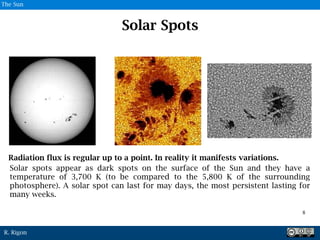6 b-radiation-the sun
- 2. R. Rigon The Sun is the origin of the water cycle 2 2 The Sun
- 3. R. Rigon The Sun is mainly composed of hydrogen. The rest is prevalently He4. Hydrogen is the fuel for the nuclear fusion that takes place inside the Sun and produces helium. However, the He4 contained in the Sun for the most part originates from previous stellar lives. Composition of the Sun 3 3 The Sun
- 4. R. Rigon Sun Fact Sheet The Sun is a G2 type star, one of the hundred billion stars of this type in our galaxy (one of the hundred billion galaxies in the known universe). Diameter: 1,390,000 km (the Earth: 12,742 km or 100 times smaller) Mass: 1.1989 x 1030 kg (333,000 times the mass of the Earth) Temperature: 5800 K (at the surface) 15,600,000 K (at the core) The Sun contains 99.8% of the total mass of the Solar System (Jupiter contains nearly all the rest). Chemical composition: Hydrogen 92.1% Helium 7.8% Other elements: 0.1% 4 4 The Sun
- 5. R. Rigon The Sun and the planets to scale 5 5 The Sun
- 6. R. Rigon The Sun’s energy is created in the core by fusing hydrogen into helium. This energy is irradiated through the radiative layer, then transmitted by convection through the convective layer, and, finally, radiated through the photosphere, which is the part of the Sun that we see. The internal structure of the Sun 6 6 The Sun
- 7. R. Rigon 7 The Sun Provide a relatively constant rate of radiation energy that in few minutes from the cromosphere arrives to the Earth. DetailofaPellizzadaVolpedoPainting
- 8. R. Rigon Solar Spots Solar spots appear as dark spots on the surface of the Sun and they have a temperature of 3,700 K (to be compared to the 5,800 K of the surrounding photosphere). A solar spot can last for may days, the most persistent lasting for many weeks. 7 8 The Sun Radiation flux is regular up to a point. In reality it manifests variations.
- 9. R. Rigon An image of the sun in X-ray band, taken by the Yohkoh solar observatory satellite, which shows changes in emissions of the solar corona from a maximum in 1991 (left) to a minimum in 1995 (right). Variability of the Emissions 8 9 The Sun
- 10. R. Rigon Solar radiation is subject to fluctuations, some of which are localised in restricted areas, while others are more global and follow an 11-year cycle. Every 11 years the sun goes from a limited number of solar spots and flares to a maximum, and vice versa. During this cycle the Sun’s magnetic poles switch orientation. The last solar minimum was in 2006. Variability of the Emissions 8 10 The Sun
- 11. R. Rigon The graph shows the solar spot cycle over the last 400 years. It should be noted that before 1700 there was a period in which very few solar spots were observed. This period coincides with the Little Ice Age, which is why there are suggestions that there is a connection between solar spot activity and the climate on Earth. The most evident cycle has a period of 11 years. But there is a second cycle which seems to have a period of 55-57 years. Variability of the Emissions 9 11 The Sun











